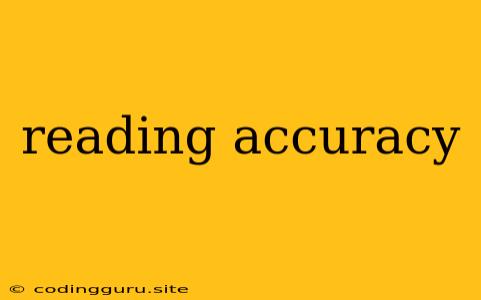What is Reading Accuracy?
Reading accuracy is a crucial aspect of reading comprehension. It refers to the ability to correctly identify and pronounce words while reading. A reader with high reading accuracy can effortlessly decode words, enabling them to focus on understanding the meaning of the text.
Why is Reading Accuracy Important?
Imagine trying to understand a story with multiple unfamiliar words. You might find yourself stumbling over words, losing your train of thought, and ultimately struggling to grasp the overall meaning. This is where reading accuracy comes in. It lays the foundation for successful reading comprehension by:
- Making reading effortless: When a reader can accurately decode words, it allows them to read fluently, which means reading with speed, accuracy, and expression. This frees up cognitive resources to focus on comprehension.
- Building confidence: Fluency and accuracy go hand-in-hand. When children can read fluently, they develop confidence in their ability to read. This confidence is essential for them to become engaged and motivated readers.
- Enhancing comprehension: Reading accuracy is the key to comprehension. If a reader cannot decode words correctly, they will not be able to understand the meaning of the text.
- Improving vocabulary: Reading accuracy is a powerful tool for building vocabulary. When children accurately decode words, they are exposed to new vocabulary words and learn their meanings through context.
How to Improve Reading Accuracy
1. Start with the basics: Make sure your child has a strong foundation in phonics. Phonics teaches children the relationship between letters and sounds, which is essential for decoding words. 2. Practice, practice, practice: The more children read, the better they become at decoding words accurately. Encourage them to read aloud regularly, even if it's just a few pages at a time. 3. Focus on sight words: Sight words are common words that children learn to recognize automatically. Practice these words frequently using flash cards, games, and other engaging activities. 4. Use multisensory approaches: Incorporate different senses to help children learn new words. This could involve using flashcards, tracing words with fingers, or using manipulatives like magnetic letters. 5. Provide supportive environments: Create a positive and encouraging reading environment at home and at school. Let children choose books that interest them, and offer support and encouragement as they read.
Strategies to assess Reading Accuracy
- Miscue Analysis: This involves observing and analyzing a reader's errors, or miscues, while reading aloud. By examining the nature of the errors, educators can gain insight into the reader's decoding strategies and identify areas for improvement.
- Oral Reading Fluency Assessments: These assessments measure a reader's ability to read a passage aloud accurately and fluently. They can provide valuable information about a reader's overall reading accuracy and fluency.
Examples of Reading Accuracy Activities
- Word sorts: Children sort words into categories based on their spelling patterns or sounds.
- Choral Reading: Children read aloud together, which can help them to practice decoding words and build confidence.
- Echo Reading: The teacher reads a sentence or passage aloud, and the child echoes the reading. This helps children develop fluency and accuracy.
- Shared Reading: The teacher and children read a text aloud together, with the teacher modeling fluent and accurate reading.
Conclusion
Reading accuracy is a fundamental skill that underpins reading comprehension. By developing strong reading accuracy, children gain the ability to unlock the world of books and become confident, engaged readers. With consistent practice and engaging activities, every child can improve their reading accuracy and embark on a lifelong journey of reading enjoyment.
